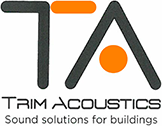Richard Groborz MIOA
Technical Director Trim Acoustics explains.
At Trim acoustics we are frequently asked “I’m looking at a product with a dB rating of 25 – what does yours do? “
Often customers have been told that an acoustic product offered has an acoustic rating of, say 20db. This would suggest that this product will reduce the sound from another area by 20dB.
Invariably this rating is the result of a sound test conducted in a laboratory to illustrate the improvement of impact noise, when tested, of a resilient material on a standard concrete floor with a mass of 365kg per M2. between two test rooms, one above the other. This test is used to produce a single figure rating of the reduction of transmitted impact noise, known as the Weighted Reduction of Impact Sound Pressure Level (ΔLw) in accordance with the British standard BS EN ISO 717
The test consists of an instrument called a tapping machine which is placed in the upper room. The tapping machine contains five hammers on a cam shaft. As the shaft rotates, the hammers hit the standard concrete floor from a predetermined height and rate producing a very loud hammering noise. This noise is measured and analysed using a sound level meter in the room below.
The material to be tested is fitted to the standard concrete floor and when the tapping machine is started the noise in the room below is again measured and analysed by the sound level meter.
The improvement in the resistance to the effect of the tapping machine is calculated and given a single number. This is then written as (number i.e. 20) ΔLw. The higher the number the better the performance of the floor covering.
A rating of ΔLw17 is used in Document E of the building regulations as a minimum requirement for impact sound through a concrete floor
Note however that this test gives no indication of resistance to airborne noise such as television, radio, talking, etc.
This number is often used by manufacturers to show the impact performance of their products, but they often fail to include the suffix ΔLw. This can cause confusion as there is another way to assess the impact performance of a floor structure where the lower the number the better. This involves performing a Document E of the Building Regulations pre completion test on site using a different test method. This test is used to determine the actual performance of a whole floor/ceiling structure.
Unfortunately unless you have a concrete floor and perfect laboratory conditions this rating is only a guide to the performance of the acoustic material.
If you put a laminate, wood or other hard floor on top of the acoustic material it reduces the effectiveness of the acoustic material substantially. Also, if your floor type is a different construction, lighter weight concrete or a timber joist floor it is difficult to judge what, if any, impact noise reduction would be achieved by an acoustic product tested by the above method.
So be careful. The dB rating only applies to a standard concrete floor. If your floor is different you may not achieve the improvement figure stated on your selected product.
The technical team at Trim acoustic have had many years of experience in the building acoustic industry and have advised members of the public, builders, architects and local authorities on the best products to use in the reduction of sound within buildings.
If you have any questions on sound reduction please contact Trimacoustics on 0208 443 0099 or look at our web site www.trimacoustics.co.uk



